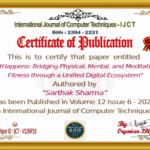
SyncPixel: A Computer Vision Framework for Automated Emotion-Based Music Suggestions | IJCT Volume 12 – Issue 6 | IJCT-V12I6P19

International Journal of Computer Techniques
ISSN 2394-2231
Volume 12, Issue 6 | Published: November – December 2025
Table of Contents
ToggleAuthor
Aman, Sanskar Gaherwal, Sarthak Sharma, Dhruv Goyal, Divy Raj
Abstract
In the age of social media, visual content plays a dominant role in digital self-expression. However, selecting the right accompanying music to match the emotional tone of an image remains a time-consuming and subjective process for users. This paper presents an intelligent system that automates this task by analyzing images to generate emotion-based song recommendations. The proposed framework leverages computer vision techniques to extract visual and contextual cues such as facial expressions, background scenery, lighting conditions, and color tone. These features are then mapped to emotional states using deep learning models, forming the basis for music recommendation through emotion–music correlation analysis. By integrating APIs such as Spotify or YouTube Music, the system curates song lists that align with the detected emotion, enhancing user experience and reducing decision fatigue. Experimental results demonstrate that the model effectively bridges visual emotion recognition and audio recommendation, offering a novel, AI-driven solution for personalized multimedia pairing in social media applications.
Keywords
Image Emotion Recognition, Computer Vision, Facial Expression Analysis, Deep Learning, Emotion Detection, Music Recommendation System, Affective Computing, Spotify API, Scene Analysis, Artificial Intelligence, Multimodal Emotion Recognition.
Conclusion
This study presents an innovative deep learning–based framework that bridges the emotional gap between visual perception and auditory experience through an intelligent, image-driven music recommendation system. By integrating advanced computer vision and affective computing techniques, the proposed model successfully interprets the emotional context embedded in visual content, translating it into meaningful musical associations. Through the combined use of DeepFace for facial emotion recognition and BLIP for image captioning and sentiment extraction, the system captures both explicit and implicit emotional cues, including facial expressions, environmental context, lighting, and color tone. These multimodal features form the foundation for accurate emotion detection, which is then mapped to appropriate musical parameters such as energy, valence, and tempo via the Spotify API to generate personalized, emotion-aligned playlists.
Experimental evaluation demonstrates that the system is capable of effectively correlating visual emotions with music genres and emotions, offering users a more intuitive, emotionally resonant, and context-aware listening experience. The approach reduces decision fatigue in music selection while fostering emotional engagement and digital self-expression. Furthermore, the use of a Streamlit-based interface ensures seamless interaction and accessibility, allowing real-time processing and visualization of detected emotions alongside the curated playlist.
From a research perspective, this work contributes to the growing domain of affective computing, human–computer interaction, and multimodal recommendation systems by showcasing how emotion understanding from non-verbal cues can enhance content personalization. The model demonstrates scalability and adaptability, making it suitable for integration into social media platforms, content creation tools, and emotion-driven entertainment systems.
Future research directions include enhancing the emotion detection pipeline using multimodal fusion with audio and textual data, implementing real-time feedback mechanisms to refine the emotion–genre mapping dynamically, and exploring transformer-based architectures for deeper contextual emotion understanding. Expanding the emotional taxonomy beyond basic categories and incorporating cross-cultural emotion modeling could further improve global applicability.
In conclusion, the proposed framework lays the foundation for next-generation emotion-aware music recommendation systems that not only respond to user preferences but also resonate with their psychological and emotional states. By merging artificial intelligence, human emotion, and artistic expression, this research represents a meaningful step toward more empathetic, adaptive, and human-centric digital ecosystems.
References
[1] P. Ekman and W. V. Friesen, “Facial Action Coding System: A Technique for the Measurement of Facial Movement,” Consulting Psychologists Press, 1978.
[2] I. Goodfellow, Y. Bengio, and A. Courville, Deep Learning, MIT Press, 2016.
[3] T. Li and M. Ogihara, “Music genre classification with taxonomy,” in Proc. IEEE Int. Conf. Multimedia and Expo, 2005, pp. 205–208.
[4] T. M. Cover and P. E. Hart, “Nearest neighbor pattern classification,” IEEE Transactions on Information Theory, vol. 13, no. 1, pp. 21–27, Jan. 1967.
[5] B. Ko, “A brief review of facial emotion recognition based on visual information,” Sensors, vol. 18, no. 2, pp. 401–419, 2018.
[6] K. Simonyan and A. Zisserman, “Very Deep Convolutional Networks for Large-Scale Image Recognition,” arXiv preprint arXiv:1409.1556, 2014.
[7] K. He, X. Zhang, S. Ren, and J. Sun, “Deep Residual Learning for Image Recognition,” in Proc. IEEE Conf. Computer Vision and Pattern Recognition (CVPR), 2016, pp. 770–778.
[8] Z. Liu, P. Luo, X. Wang, and X. Tang, “Deep Learning Face Attributes in the Wild,” in Proc. IEEE Int. Conf. Computer Vision (ICCV), 2015, pp. 3730–3738.
[9] F. Eyben, F. Weninger, F. Gross, and B. Schuller, “Recent developments in openSMILE, the Munich open-source multimedia feature extractor,” in Proc. ACM Multimedia (MM), 2013, pp. 835–838.
[10] D. Herremans, E. Chew, and D. Herremans, “Automatic music generation and emotion recognition: A survey,” IEEE Transactions on Affective Computing, vol. 10, no. 4, pp. 579–595, 2019.
[11] Spotify Developers, “Spotify Web API Documentation,” [Online]. Available: https://developer.spotify.com/documentation/web-api/
How to Cite This Paper
Aman, Sanskar Gaherwal, Sarthak Sharma, Dhruv Goyal, Divy Raj (2025). SyncPixel: A Computer Vision Framework for Automated Emotion-Based Music Suggestions. International Journal of Computer Techniques, 12(6). ISSN: 2394-2231.










